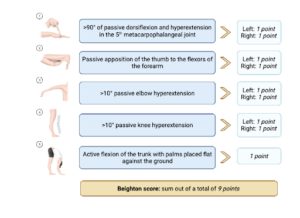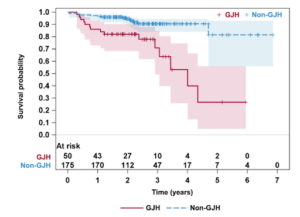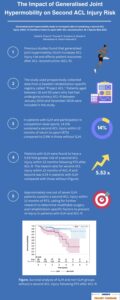Why is this study important?
Anterior cruciate ligament (ACL) injuries are common among athletes, especially those participating in high-intensity sports with cutting and pivoting movements, such as football, basketball, and handball. Knee stability and function after ACL injury can be restored surgically through ACL reconstruction (ACL-R). However, not all patients who undergo ACL-R are able to return to sport (RTS) without complications and reinjury. Generalized joint hypermobility (GJH) is a clinical phenotype characterized by excessive mobility of synovial joints that has previously been implicated to increase the risk of primary ACL injury and graft failure after ACL-R. A recent study published in the British Journal of Sports Medicine found that patients with GJH are at a 5.53-fold greater risk of a second ACL injury within 12 months of returning to sport after primary ACL-R. This study is important because it highlights the need to screen patients undergoing ACL-R for GJH to optimize favorable outcomes and avoid the incidence of second ACL injury after RTS (1).
How did the study go about this?
The study analyzed data from Project ACL, a prospective Swedish rehabilitation-specific registry and included 16-50-year-old patients treated with ACL-R between 2014 and 2019. The study compared the rates of second ACL injury within 12 months of RTS between patients with and without GJH. The study also evaluated patient-reported outcomes frequently used to determine self-reported knee function in patients treated for ACL injury, including the ACL-Return to Sports Index (ACL-RSI), Knee Injury and Osteoarthritis Outcome Score (KOOS), Knee-Self Efficacy Scale (K-SES) and a modified version of the Tegner Activity Scale. The Beighton score was used to determine the presence of GJH in patients with ACL-R, assessed and recorded by a single investigator (not necessarily the same for each patient) in this study. The Beighton score included the joint mobility tests displayed on Figure 1 (1).

Figure 1
What did the study find?
Within 12 months of RTS, 14% of patients with GJH and 2.9% without GJH had a second ACL injury. Logistic regression analysis showed that GJH led to a 5.53-fold odds of sustaining a second ACL injury within 12 months of RTS. Cox-regression analysis determined a lifetime hazard ratio of 4.24 for second ACL injury in patients with 12 months or longer follow-up after RTS. However, there were no differences in patient-reported outcomes between patients with and without GJH (Figure 2) (1).

Figure 2
What are the key take-home points?
Patients with GJH who undergo anterior cruciate ligament (ACL) reconstruction have a significantly greater risk of sustaining a second ACL injury after RTS compared with patients without GJH. Additionally, GJH was independently associated with an increased risk of both ipsilateral and contralateral ACL reinjury. The current research highlights the importance of GJH assessment in patients with ACL-R, since GJH poses over a 5-fold risk of second ACL injury in the study’s patient population. Future research is encouraged for the collection of long-term outcome data, comparison of the independent roles of knee hyperextension and GJH on reinjury risk and the investigation of the influence of surgical variables on postoperative outcomes after ACL-R. The impact of individualized graft selection and additional surgical techniques with a potential protective effect on the ACL graft in patients with GJH and ACL-R may warrant further assessment. Furthermore, patients with GJH and ACL-R may benefit from rehabilitation protocols with criteria tailored specifically to the GJH population to achieve clearance for RTS.

Authors:
Bálint Zsidai, Ramana Piussi, Roland Thomeé, David Sundemo, Volker Musahl, Kristian Samuelsson, Eric Hamrin Senorski
References:
1. Zsidai B, Piussi R, Thomee R, et al. Generalised joint hypermobility leads to increased odds of sustaining a second ACL injury within 12 months of return to sport after ACL reconstruction. Br J Sports Med 2023;57(15):972-78. doi: 10.1136/bjsports-2022-106183 [published Online First: 2023/05/17]